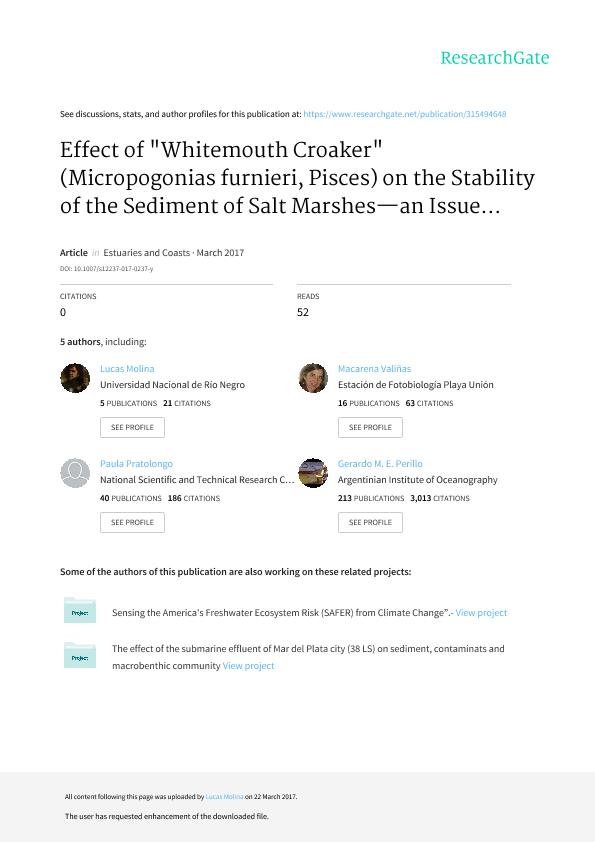Mostrar el registro sencillo del ítem
dc.contributor.author
Molina, Lucas Matías

dc.contributor.author
Valiñas, Macarena Soledad

dc.contributor.author
Pratolongo, Paula Daniela

dc.contributor.author
Elias, Rodolfo

dc.contributor.author
Perillo, Gerardo Miguel E.

dc.date.available
2017-11-02T18:36:04Z
dc.date.issued
2017-03
dc.identifier.citation
Molina, Lucas Matías; Valiñas, Macarena Soledad; Pratolongo, Paula Daniela; Elias, Rodolfo; Perillo, Gerardo Miguel E.; Effect of “Whitemouth Croaker” (Micropogonias furnieri, Pisces) on the Stability of the Sediment of Salt Marshes—an Issue To Be Resolved; Springer; Estuaries and Coasts; 40; 6; 3-2017; 1795-1807
dc.identifier.issn
1559-2723
dc.identifier.uri
http://hdl.handle.net/11336/27436
dc.description.abstract
Among the predators, fish are prevalent in intertidal soft-bottom zones, and many create substantial interruptions in the sediment surface through their feeding, thus affecting the movement of fluids in the sediment-water interface and therefore the rates of deposition and local erosion. This study was designed to determine whether or not Micropogonias furnieri—an ecologically significant benthophagic southwestern Atlantic Ocean predator—modified erosion and/or sedimentation processes in salt marshes. The results indicated that this species exhibited a preference for areas without vegetation cover at the time of feeding since a greater abundance of pits was found in those environments. Moreover, the volume analysis of the pits in the two areas indicated that the size of the fish that had foraged in the sediment was significantly larger in the nonvegetated areas. The results of the M. furnieri-exclusion experiment indicated that the presence of this sciaenid neither resulted in a decrease in benthic organisms in the nonvegetated areas nor affected the vertical distribution of the infauna. When M. furnieri was excluded, the sediment exhibited higher critical-shearing and frictional-velocity values than in areas where M. furnieri had access and therefore was less likely to be eroded. The data from these experiments enabled us to conclude that the foraging action of M. furnieri modified the stability of the sediment as a result of the predatory pressure that the fish exerted on the organisms inhabiting the salt marshes, thus resulting in the generation of elliptical depressions. That modification of the sediment stability was evidenced in two principal ways: (i) a negative effect on the microphytobenthic organisms that decreased the concentration of extracellular polymeric substances in the sediment and (ii) an increased roughness of the bottom and increased percentage of sand in the particle composition of the sediment, where the fish had foraged.
dc.format
application/pdf
dc.language.iso
eng
dc.publisher
Springer

dc.rights
info:eu-repo/semantics/openAccess
dc.rights.uri
https://creativecommons.org/licenses/by-nc-sa/2.5/ar/
dc.subject
BAHÍA BLANCA ESTUARY
dc.subject
BIOTURBATION
dc.subject
CSM
dc.subject
FISH PREDATION
dc.subject
NEKTON
dc.subject
POLYCHAETE
dc.subject
SALTMARSHES
dc.subject
SEDIMENT STABILITY
dc.subject
SPARTINA ALTERNIFLORA
dc.subject.classification
Oceanografía, Hidrología, Recursos Hídricos

dc.subject.classification
Ciencias de la Tierra y relacionadas con el Medio Ambiente

dc.subject.classification
CIENCIAS NATURALES Y EXACTAS

dc.title
Effect of “Whitemouth Croaker” (Micropogonias furnieri, Pisces) on the Stability of the Sediment of Salt Marshes—an Issue To Be Resolved
dc.type
info:eu-repo/semantics/article
dc.type
info:ar-repo/semantics/artículo
dc.type
info:eu-repo/semantics/publishedVersion
dc.date.updated
2017-10-12T19:34:22Z
dc.journal.volume
40
dc.journal.number
6
dc.journal.pagination
1795-1807
dc.journal.pais
Alemania

dc.journal.ciudad
Berlín
dc.description.fil
Fil: Molina, Lucas Matías. Universidad Nacional de Rio Negro. Centro de Investigaciones y Transferencia de Rio Negro. Consejo Nacional de Investigaciones Científicas y Técnicas. Centro de Investigaciones y Transferencia de Rio Negro.; Argentina. Consejo Nacional de Investigaciones Científicas y Técnicas; Argentina
dc.description.fil
Fil: Valiñas, Macarena Soledad. Consejo Nacional de Investigaciones Científicas y Técnicas; Argentina
dc.description.fil
Fil: Pratolongo, Paula Daniela. Consejo Nacional de Investigaciones Científicas y Técnicas. Centro Científico Tecnológico Conicet - Bahía Blanca. Instituto Argentino de Oceanografía. Universidad Nacional del Sur. Instituto Argentino de Oceanografía; Argentina. Universidad Nacional del Sur. Departamento de Biología, Bioquímica y Farmacia; Argentina
dc.description.fil
Fil: Elias, Rodolfo. Consejo Nacional de Investigaciones Científicas y Técnicas. Centro Científico Tecnológico Conicet - Mar del Plata. Instituto de Investigaciones Marinas y Costeras. Universidad Nacional de Mar del Plata. Facultad de Ciencia Exactas y Naturales. Instituto de Investigaciones Marinas y Costeras; Argentina
dc.description.fil
Fil: Perillo, Gerardo Miguel E.. Consejo Nacional de Investigaciones Científicas y Técnicas; Argentina. Consejo Nacional de Investigaciones Científicas y Técnicas. Centro Científico Tecnológico Conicet - Bahía Blanca. Instituto Argentino de Oceanografía. Universidad Nacional del Sur. Instituto Argentino de Oceanografía; Argentina. Universidad Nacional del Sur; Argentina
dc.journal.title
Estuaries and Coasts

dc.relation.alternativeid
info:eu-repo/semantics/altIdentifier/doi/http://dx.doi.org/10.1007/s12237-017-0237-y
dc.relation.alternativeid
info:eu-repo/semantics/altIdentifier/url/https://link.springer.com/article/10.1007%2Fs12237-017-0237-y
Archivos asociados
